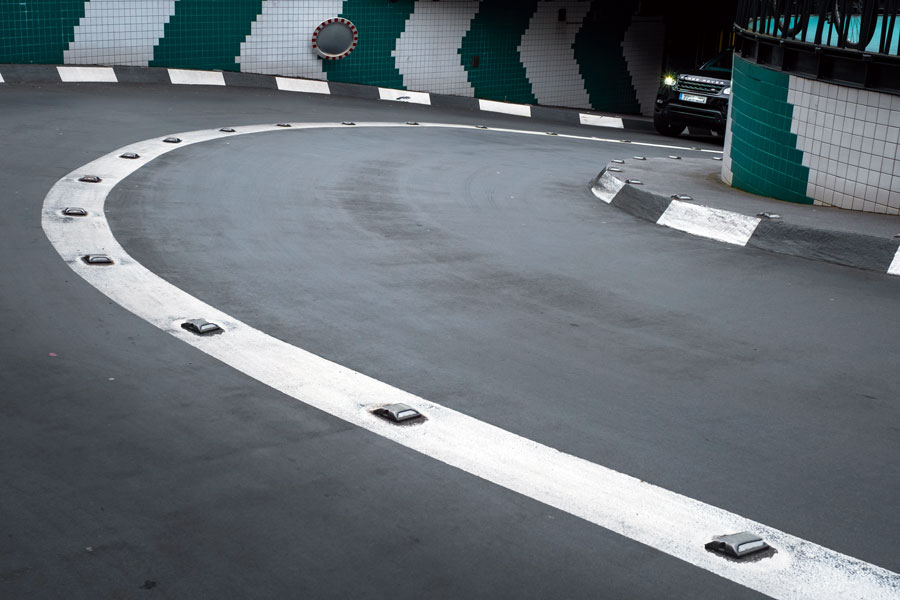All about reflective pavement markers and line marking for roads

These reflective pavement markers are perfect for your next road project
This article explores the different types of reflective road markers, line marking techniques and products, and temporary vs permanent pavement marking. It also covers what the different colours of reflective road markers mean, and looks at different ways to install them.
What are reflective pavement markers used for?
Retro-reflective raised pavement markers are used to enhance longitudinal lines on the road, outline certain directional markings, and add to the edges of lines. Basically, they add to the visibility of line marking on the road surface, creating a greater overall effect, especially at night or in low light conditions.
Specifications from state road authorities, such as RMS Spec R142, cover off all the approved products and methods for installing reflective pavement markers in NSW. Along with the RMS delineation documentation, other road authorities have similar specifications to ensure that road markings and reflectors used on state road networks are clear, uniform and safe.
ROAD MARKING TERMS
Road markings glossary: some common meanings
There are a lot of different names for reflective pavement markers – here’s a quick list to help demystify some of the slang terms and abbreviations.
RRPM – raised reflective pavement marker
Cat’s eye – a colloquial term for a RRPM
TRPM – temporary raised pavement marker
Stick ‘n’ stomp – a colloquial term for a TRPM
Which colour road reflectors do I need?
When the time comes for permanent line marking to take place, you’ll need to add raised reflective pavement markers as well. These reflectors, also known as RRPMs or cats eyes, come in different colours to indicate different road features and are part of the final finish of the road or pavement.
Here’s what the different colours indicate:
Yellow pavement markers are used on the dividing line that separates traffic, to outline islands and medians, and also on the right hand edge lines of dual carriageways.
Red reflective road markers are used on the left hand edge lines of dual carriageways.
White reflectors are used on lanes, in between dashed markings or on either side of unbroken lines.
Blue road markers are used to mark fire hydrants and other water supplies. They are normally installed 100mm from the line on the road shoulder, enabling easy location of a fire hydrant or water source. Blue markers shouldn’t be used for other pavement marking purposes.
Using stick ‘n’ stomps or temporary reflective markers
When new road surfaces have been laid down it is often a requirement of the job to add reflective markers. However, sometimes the road is opened to traffic before line marking can take place.
Temporary pavement markers, also known as stick ‘n’ stomps, are a great short term solution to mark asphalt and pavements before permanent line marking takes place. They provide a way to delineate lanes and edges before the permanent longitudinal line marking process takes place.
Stick ‘n’ stomps are available in yellow or white and come with a Class 1A reflective strip applied to tough high impact plastic. They are an economical solution for making newly laid roads safer. An easy to remove clear cover protects the reflective film during sealing and is easily ripped off afterwards.
Installing reflective pavement markers
Before you install reflective pavement markers it’s necessary to check the required road authority specification for the state road network, or you may need to check with local councils for local roads. The body that looks after the roads in your area will be able to offer guidelines on how best to approach line marking operations.
Jaybro supplies Australian line marking contractors with two types of tar pads designed for fixing RRPMs to the pavement. There is a heat-activated tar pad, and a sticky butyl pad which does not require heating. Both of these sticky pads are sized to match the size of the reflectors.
Another option is epoxy glues which require a longer setting or curing time.
Heat activated tar pads
These are a great solution for installing road reflectors, as they only take 90 seconds to install. Using a gas torch to apply heat enables the tar to become soft and tacky, so that you can simply heat the pad and stick the pavement marker onto it.
Self-adhesive butyl pavement marker pads
These tar pads have sticky surfaces on both sides, and are better suited to temporary or construction zone situations. These quick and easy pads require no heating of road surface or marker pad prior to use, and roads can be re-opened immediately.
Installing road markers with epoxy
Megapoxy is a gunnable two part epoxy that is ions for bonding reflective pavement markers to bitumen and concrete surfaces. Megapoxy 36 conforms to all the requirements of RTA specification 3554 Adhesives for Raised Pavement Markers and is also approved by other road authorities.
How to create perfect pavement lines with a line marking machine
 Line-marking is a critical part of finishing a road to make it safe for motorists. Longitudinal line marking is typically done with a specially designed cart, trolley or truck, enabling the user to apply the white road line marking paint in bulk. These permanent paints are normally thermoplastic, meaning they are applied hot, and as they set and harden they become a strong polymer that is resistant to the wear and tear of vehicles.
Line-marking is a critical part of finishing a road to make it safe for motorists. Longitudinal line marking is typically done with a specially designed cart, trolley or truck, enabling the user to apply the white road line marking paint in bulk. These permanent paints are normally thermoplastic, meaning they are applied hot, and as they set and harden they become a strong polymer that is resistant to the wear and tear of vehicles.
Line marking on roads can also be done in a more temporary or small-scale fashion with a line marking machine that takes aerosol paint cans in a holster. These can be used to spray road marker paint lines on asphalt and pavements, as well as on sporting fields and areas like concrete car parks.
Line marking machines take cans of spray paint which can be mounted at the side or rear. Paints like the Ultracolour acrylic road and line marking paint offer very good resistance to both vehicular and pedestrian traffic. Because it contains acrylic resin, it can provide superior UV resistance for a low-maintenance finish in the long run.
Creating perfectly straight lines takes practice. It’s important to ensure the area is as clean and level as possible, and that high quality road marker pain paint is used for a good opaque finish.
There are many professional line marking contractors across Australia that are highly experienced at marking straight lines, so even if you are marking a small area like a car park, driveway or sports court, you might like to consult an expert for a quote.
A linemarking machine is ideal for marking large areas with line marking paint, such as carparks, concrete areas and pavements.
Shop for reflective pavement markers and line marking supplies at Jaybro
We’ve got a whole range of products to help you get a quality finish on your line marking project. From reflective pavement markers to installation supplies, line marking paints and machines, we can help road marking professionals get the best products at great prices.
Request a quote or shop our online store for reflectors and road marking supplies.
 Sign In
Sign In 






